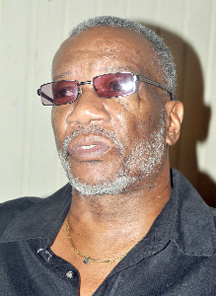By Iva Wharton
The lack of maintenance of community grounds continues to hamper the development of sports in Guyana, according to Presidential Advisor on Empowerment, Odinga Lumumba.
Lumumba in an exclusive interview with Stabroek Sport said that government is not to be blamed, but he cited the weather condition and residents who use the grounds as pasture for their animals to graze.

“We have a problem with rainfall in Guyana and the soil that we have, grounds are destroyed in particular in communities where people don’t take care of the grounds in the sense of the gates, to make sure cows, goats and horses are prevented from entering. Some people put their animals in the grounds so that destroys them.”
Rehabilitation of grounds, he said, is very expensive “as you need the use of a tractor, you have to level the ground, throw sand, roll the ground and in real terms with this kind of weather condition you are supposed to do that three times per year,” and the cost, he added, cannot be borne by many of the Neighbourhood Democratic Councils (NDCs). The NDCs, he said, are the bodies responsible for such maintenance.
“And that has an impact on sports development because if six months in the year an athlete or sport cannot be productive, it affects the efficiency of the player or sportsman because he does not have access to the facilities.”
Lumumba said in his opinion grounds should be controlled by NGOs or large companies with the finances to maintain them.
“But if you just have a ground and say that Pele, Alpha or anybody can use the ground, then it becomes the question of how you will maintain it.”
Guyana, he said, has too many grounds with some communities having as many as three and these are too expensive to maintain.
“I think we could have two or three grounds per area, NDC or Region and you put more resources to maintain those grounds and athletes can have access to them throughout the year. That’s the problem, too many grounds and limited resources.
Whenever people see a ground they think government, but those things are under the NDCs and Region. Government does not own any grounds.”
He also said it is no different with the community centres as many have been left to deteriorate over the years and then the government has to step in and assume the responsibility when it should not have had to.
Lumumba was at the time responding to questions about the Andrew ‘Six Heads’ Lewis gym, Albouystown which is now the responsibility of the Guyana Amateur Boxing Association.
“We don’t have the time, we need an entity like the amateur boxing association that can put more effort into it. Most of the buildings are built for the community and we step in when the community fails.”
Many of the facilities built in communities are operated by youth groups but some are not able to maintain them properly.
One of the major challenges facing many of the groups running the facilities is maintenance. “It’s very difficult because many of the youth groups do not have access to funds, but some youth groups especially from Berbice have been creative enough to work with NGOs.”
That, he said, is one of the objectives for turning over the operations to the community so that they can use their initiative, which makes them self-sufficient.
“In cases where they need us to step in we need to find other people, like we have a centre in Hope Town, West Coast Berbice – it’s in and out, some days you have management, other days you don’t, some days you have one youth group running it for six months, then it collapses. Now we see some people using their initiative and we’re hoping they succeed.” He said that the structures are there, but the problem is the management of the facilities.
According to Lumumba the government receives a number of requests to run the facilities “but we are trying to focus in my area, to focus on things where the maintenance is not too heavy or the maintenance does not require government subvention. For example we do a lot of small pavilions, basketball courts and a few more community centres but not many.”
He said that although the maintenance costs are high they try to maximize the uses until some group or organization assumes the responsibility.





